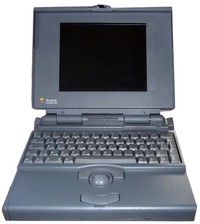Apple Macintosh PowerBook 180C
| Home > Browse Our Collection > Computers > Apple Computers > Apple Macintosh PowerBook 180C |
|
The PowerBook 180 was the first portable Mac with a 4-bit active matrix display. With a 33 MHz CPU and improved screen, it replaced the PB 170 and was in very high demand through its life. Like the PB 160, the 180 has a video out port supporting an external 13" to 16" monitor. With the PB 160, it was the first PowerBook to support more than 8 MB of RAM.
The PB 180 reintroduced SCSI Disk Mode to the PowerBook line, a feature previously found only on the PB 100.
As with all early PowerBooks, when buying used be sure it has all the memory you need (new PB RAM is getting more difficult to locate, especially at reasonable prices).
The PB 180 has a 14 MB memory ceiling, although you can go beyond that by using Virtual Memory (slow and free) or RAM Doubler (faster, not free, and discontinued). Another option is RAM Charger 8.1, which offers better memory management than the Mac OS.
Details
•introduced 19/10/1992.at US$4,110; discontinued 01/05/1994 •requires System 7.1 to 7.6.1, supports Mac OS 8.1 with Born Again •CPU: 33 MHz 68030 •FPU: 68882 •performance: 4.5, relative to SE; 0.54, Speedometer 4 •ROM: 1 MB •RAM: 4 MB, expandable to 14 MB using a special 85ns pseudostatic RAM card •display: 9.8" 4-bit active matrix •80 MB or 120 MB hard drive standard •ADB: 1 port for keyboard and mouse •serial: 2 DIN-8 RS-422 ports on back of computer •SCSI: HDI30 connector on back of computer •proprietary modem slot •Gestalt ID: 33 •Size (HxWxD): 2.25" x 11.25" x 9.3" •weight: 6.8 pounds •power supply: M5651 - 19W, 2 amps This and further information from http://lowendmac.com/pb/powerbook-180.html
Our unit PowerBook 180C has the model no: M7940 and was introcuced in June 1993 and is complete with power supply.
Manufacturer: Apple Comment on This Page Magazines RELATED to Apple Macintosh PowerBook 180C in our Library
Other Systems Related To Apple Macintosh PowerBook 180C:This exhibit has a reference ID of CH5421. Please quote this reference ID in any communication with the Centre for Computing History. |
Click on the Image(s) For Detail
|
























